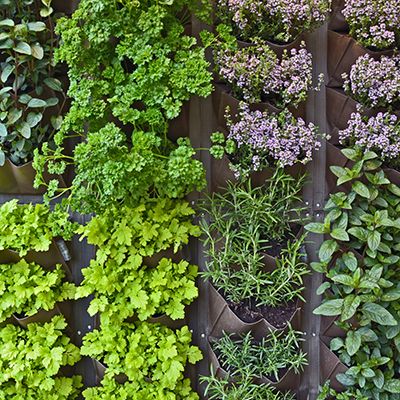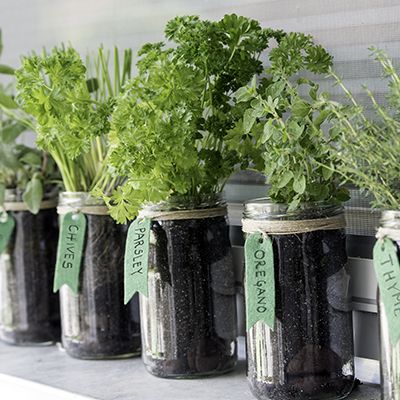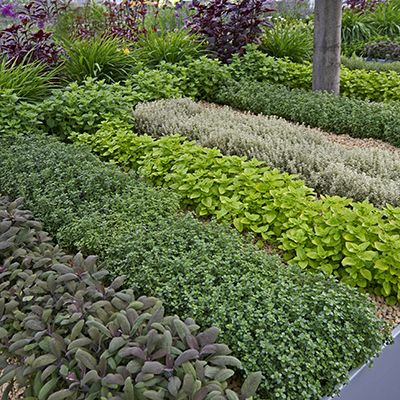


Herbs
General Information: If you think of herbs as wild plants, think again. Herbs have undergone centuries of selection and although less formal and showy than common garden flowers, have a presence all their own. Incorporated into the garden or landscape design and given modest attention and grooming, they can be among the most beautiful plants in the garden.
Uses: More than just an attractive feature in the garden, herbs have multiple uses as seasonings, teas and tisanes, garnishes, fragrances, dyes, cosmetics, and medicines. Many of the herbs grown today as ornamentals, were valued originally for medicinal or ritual uses and are cloaked in folklore and superstition. Additionally, most herbs attract both pollinating and predatory beneficial insects into the yard which play an important role in integrated pest management.
Herbs can be utilized in garden design by treating them as you would other annuals, perennials and shrubs; that is, sort them by height and spread, perennial or evergreen, time of flower, if desired, and longevity (e.g. annual or perennial). They can be used as edging plants, groundcovers, backgrounds plants, or even focal plants, depending on your aesthetic preferences. Low, spreading herbs such as skullcap are naturals for rock gardens and walls, and mint or creeping rosemary can be used as a groundcover on hillsides. Some reseeding herbs, such as chamomile, will take hold between flagstones and come back year after year. Placing herbs where they will be lightly bruised by foot or in passing will release their fragrance, a prized attribute in landscaping. Herbs that remain neat and low such as thyme, dwarf sage, or "spicy globe" basil can be used as edging in flower beds or borders. Herbs that grows somewhat erect such as chives and ‘blue spires’ rosemary can be used to frame focal plants. Flowering herbs such as Echinacea, lavender, yarrow, and calendula deserve focal point placement or work well as participants in perennial beds.
Herbs also make excellent container plants, an important feature if garden space is restricted or if plants need to be portable. Make sure you water more frequently in containers as they dry out faster than those in the ground.
Many herbs are actually small perennial shrubs which do well in containers. Among these are: oregano, rosemary, thyme and marjoram. These should be planted in one- or two-gallon containers with Gardner & Bloome® Organic Potting Soil. Annual herbs such as basil, cilantro and parsley grow well in one gallon or larger containers with the same care as for the perennial herbs. Fertilize container herbs lightly every two months, with a low nitrogen fertilizer such as Master Nursery® Tomato & Vegetable Food, water as needed and place on the hottest place of your patio to produce the most intense flavor. Trim to shape as needed and save the trimmings by freezing in a Ziploc bag or drying in the oven.
Light: Plant your herbs in areas that receive six to eight hours of sun. Morning sun is better for annual herbs that are grown for culinary purposes. If annual herbs get too much afternoon sun, they bloom and go to seed more quickly. This prevents production of useable foliage. Most perennial herbs can grow in morning or afternoon sun. Perennial herbs such as oregano or thyme produce more compact and strongly scented foliage if they receive strong afternoon sun.
Planting & Fertilizing: Use potting soil, such as Gardner & Bloome® Organic Potting Soil, for potted plants or add one-third Master Nursery® Gold Rush to your native soil as a mix for planting perennial herbs in the ground. For annual herbs such as cilantro, chives, basil and parsley, mix two to three inches of Master Nursery® Gold Rush into the top, six to eight inches of garden soil to produce a loose, well-draining mixture. If the soil runs heavily to clay, scatter 10 pounds of gypsum and twp pounds of Master Nursery® Master Start per 100 square feet over the area before mixing in the Master Nursery® Gold Rush. Herbs planted in the ground should be fertilized lightly with Master Nursery® Tomato and Vegetable Food once a year about July 4th. Herbs should not be over-watered or over-fertilized as this stimulates soft, insipid growth.
If annual herbs get mostly afternoon sun, they tend to “bolt” after a few weeks. Pinch off the flower stalks and replant another crop of the same plants at this time to ensure a continuous supply of these herbs.
Spraying: If insect problems develop, use Master Nursery® Take Down Garden Spray to control a wide range of insects. It is derived from botanical pyrethrins, and canola oil so is safe to use on edible herbs. If aphids are the only problem, Safer® Brand Insect Killing Soap will take care of them. Soap has no residual effect so you need to hit them. If mildew occurs, use Safer® Brand Garden Fungicide, a sulfur-based product which controls powdery mildew, leaf spot, and rust.
We mentioned a few uses of herbs for other than culinary purposes. The following are a few more herbs which can see service as medicinal or ornamentals: anise, hyssop, Russian sage, catmint, all the mints, pepino, alpine strawberry, Kalanchoe pumila, ornamental pepper, lemon grass, the salvias, scented geraniums, feverfew and Plectranthus.
Finally, is the matter of pronunciation? Is it “herb” or “erb”? In the British Isles (and some former colonies) you sound the “h”. In the United States and France, the “h” remains silent.